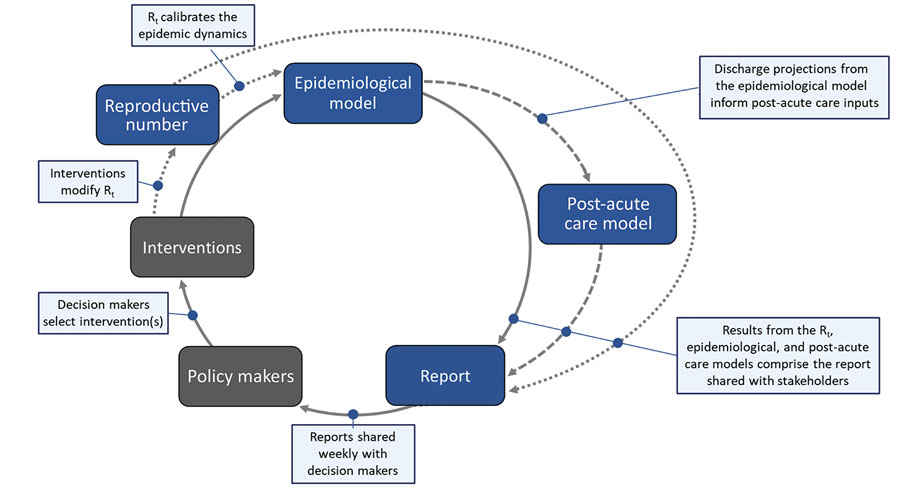Coordinated Strategy for a Model-Based Decision Support Tool for Coronavirus Disease, Utah, USA
Hannah R. Meredith, Emerson Arehart
1, Kyra H. Grantz
1, Alexander Beams, Theresa Sheets, Richard Nelson, Yue Zhang, Russell G. Vinik, Darryl Barfuss, Jacob C. Pettit, Keegan McCaffrey, Angela C. Dunn, Michael Good, Shannon Frattaroli, Matthew H. Samore, Justin Lessler, Elizabeth C. Lee, and Lindsay T. Keegan

Author affiliations: Johns Hopkins Bloomberg School of Public Health, Baltimore, Maryland, USA (H.R. Meredith, K.H. Grantz, S. Frattaroli, J. Lessler, E.C. Lee); University of Utah, Salt Lake City, Utah, USA (E. Arehart, A. Beams, T. Sheets, R. Nelson, Y. Zhang, R.G. Vinik, D. Barfuss, J.C. Pettit, M. Good, M.H. Samore, L.T. Keegan); Utah Department of Health, Salt Lake City (K. McCaffrey, A.C. Dunn); Veterans Affairs Salt Lake City Health Care System, Salt Lake City (M.H. Samore, L.T. Keegan)
Main Article
Figure 1

Figure 1. Schematic of the modeling process used as a decision support tool for coronavirus disease, Utah, USA. The epidemiologic model produces outputs of disease impact and key health outcomes that are used by the post–acute-care model. All model results are incorporated into the report, which is generated weekly and shared with policymakers who then make decisions on which interventions to implement. Those interventions impact the reproductive number, which is then used as an input to the epidemiologic model. The color of the box represents the time input was added, with dark blue for earliest and light blue for most recent. Policymakers and interventions are gray to indicate that although they are a critical component of our modeling process, they are external to our inputs to the process. Rt, real-time effective reproduction number.
Main Article
Page created: March 26, 2021
Page updated: April 20, 2021
Page reviewed: April 20, 2021
The conclusions, findings, and opinions expressed by authors contributing to this journal do not necessarily reflect the official position of the U.S. Department of Health and Human Services, the Public Health Service, the Centers for Disease Control and Prevention, or the authors' affiliated institutions. Use of trade names is for identification only and does not imply endorsement by any of the groups named above.
